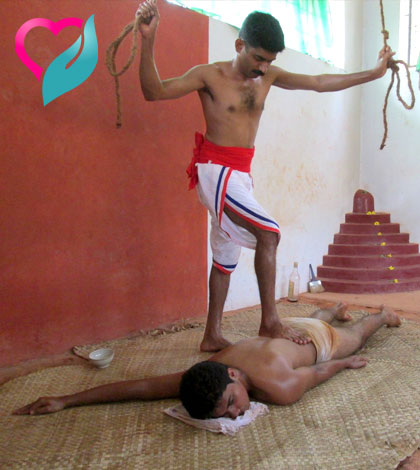(Kalari Chikilsa) in Lumbar Inter-Vertebral Disc Prolapse (IVDP)
Kalaripayattu (Kalari abhyasam), an Indian martial art form from the southern state Kerala, is formed by the ancient Gurus completely on the basis of the human anatomy and the Nature.
Kalari therapy is a unique system of treatment developed by Kalari masters throughout the centuries. It actually originated as a treatment for students practicing Kalaripayattu but now a days this system of medicine gained its popularity among common people especially for the treatment of orthopedic disorders and neuromuscular problems like Arthritis (64 types), Migraine (6types), Back pain, sciatica, spondylitis, Dis Prolapse, Hip pain, Joint problems affecting knees, elbows, shoulders, bones fractures etc.
The underlying principle of Kalari Chikilsa is that an abnormality to any system of the human body such as nervous system, musculoskeletal system can happen only if anyone or more of the 107 vital spots are bruised. The treatment is all about detecting the vital spots affected and curing them to normalcy.
The present study investigated the role of Kalari Chikitsa in the lumbar inter-vertebral disc prolapse (IVDP) among a group of 215 patients who are clinically diagnosed. The study was done during the period of 2008-2013. The index cases in the population studied were entered into a structured questionnaire taking into account the history of insult, the grade of insult, duration and physical incapacity the patient had at the time of presentation. The status of the patients was assessed by proper clinical examination. In indicated cases, investigations (x-Ray, MRI) were performed in consultation with orthopaedician and the nature extends and grade of insult was documented. Those patients who opted for traditional system of treatment after being fully evaluated by orthopaedicians were included into the study. The modalities of treatment in all cases were same.
The treatment protocols include medicated bandage which is a combination of five dried medicines with egg white (albumen) and apply to the lumbar region and keep it for 24hrs. This treatment duration is for 5 days and also the application of Kizhi in which medicines are made into fine powder and make a bolus with cloth, and make it hot by immersing it into hot oil and apply to the lumbar region. The patients were given Rasnaguluchyadi Kashayam for 21 days for the reduction of pain and inflammation. Supplementation of purified castor oil which is treated with Vitex negundo (Nirgundi) is given to clear the bowel.
Instructions were given regarding the diet, physical activity, abstinence from smoking and alcohol and sexual intercourse. All the patients were instructed to attend to diet and regular standardized graded exercise to achieve bulk and strength of the wasted paraspinal muscles. Mahanadi Thailom (medicated oil) was given to all the patients to stimulate the recovering nerve.
All patients had neurological recovery within the first 3 days of treatment and in addition to that relief of pain and spasm were hand in hand an all had recovery in 3 to 5 days. Change in SLR and featuring radiculitis had similar pattern and recovery of sciatica was achieved in 2 to 3 weeks. None of the patients in my study had observed any bladder incontinence. Overall study point out that the traditional kalari treatment is at par or even a better solution for the treatment of symptomatic uncomplicated IVDP of lumbar region
Dr. Sunil.S.Kaimal MD(AM)
email: suncvn@gmail.com,
website: www.suncvnkalari.com
Image courtesy: blogspot.com , astanga.pl ,






















